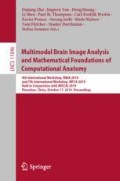Abstract
Mild Cognitive Impairment (MCI) is a clinically intermediate stage in the course of Alzheimer’s disease (AD). MCI does not always lead to dementia. Some MCI patients may stay in the MCI status for the rest of their life, while others will develop AD eventually. Therefore, classification methods that help to distinguish MCI from earlier or later stages of the disease are important to understand the progression of AD. In this paper, we propose a novel computational framework - named Augmented Graph Embedding, or AGE - to tackle this challenge. In this new AGE framework, the random walk approach is first applied to brain structural networks derived from diffusion-weighted MRI to extract nodal feature vectors. A technique adapted from natural language processing is used to analyze these nodal feature vectors, and a multimodal augmentation procedure is adopted to improve classification accuracy. We validated this new AGE framework on data from the Alzheimer’s Disease Neuroimaging Initiative (ADNI). Results show advantages of the proposed framework, compared to a range of existing methods.
Access this chapter
Tax calculation will be finalised at checkout
Purchases are for personal use only
References
Petersen, R.C., et al.: Current concepts in mild cognitive impairment. Arch. Neurol. 58(12), 1985–1992 (2001)
Dawe, B., Procter, A., Philpot, M.: Concepts of mild memory impairment in the elderly and their relationship to dementia - a review. Int. J. Geriatr. Psychiatry 7(7), 473–479 (1992)
Petersen, R.C.: : Clinical characterization and outcome (vol 56, pg 303, 1999). Arch. Neurol-Chic. 56(6), 760 (1999)
Lee, E.S., et al.: Default mode network functional connectivity in early and late mild cognitive impairment results from the Alzheimer’s disease neuroimaging initiative. Alzheimer Dis. Assoc. Disord. 30(4), 289–296 (2016)
Aisen, P.S., et al.: Clinical core of the Alzheimer’s disease neuroimaging initiative: progress and plans. Alzheimer’s Dement. 6(3), 239–246 (2010)
Goryawala, M., Zhou, Q., Barker, W., Loewenstein, D.A., Duara, R., Adjouadi, M.: Inclusion of neuropsychological scores in atrophy models improves diagnostic classification of alzheimer’s disease and mild cognitive impairment. Comput. Intell. Neurosci. 2015, 865265 (2015)
Shakeri, M., Lombaert, H., Tripathi, S., Kadoury, S.: Deep spectral-based shape features for Alzheimer’s disease classification. In: Reuter, M., Wachinger, C., Lombaert, H. (eds.) SeSAMI 2016. LNCS, vol. 10126, pp. 15–24. Springer, Cham (2016). https://doi.org/10.1007/978-3-319-51237-2_2
Korolev, S., Safiullin, A., Belyaev, M., Dodonova, Y.: Residual and plain convolutional neural networks for 3D brain MRI classification. In: 2017 IEEE 14th International Symposium on Biomedical Imaging (ISBI 2017), pp. 835–838. IEEE (2017)
Jessen, F., et al.: AD dementia risk in late MCI, in early MCI, and in subjective memory impairment. Alzheimer’s Dement. 10(1), 76–83 (2014)
Hett, K., Ta, V.-T., Giraud, R., Mondino, M., Manjón, José V., Coupé, P.: Patch-based DTI grading: application to Alzheimer’s disease classification. In: Wu, G., Coupé, P., Zhan, Y., Munsell, Brent C., Rueckert, D. (eds.) Patch-MI 2016. LNCS, vol. 9993, pp. 76–83. Springer, Cham (2016). https://doi.org/10.1007/978-3-319-47118-1_10
Singh, S., et al.: Deep-learning-based classification of FDG-PET data for Alzheimer’s disease categories. In: 13th International Conference on Medical Information Processing and Analysis, 2017, vol. 10572, p. 105720 J. International Society for Optics and Photonics (2017)
Tripathi, S., Nozadi, S.H., Shakeri, M., Kadoury, S.: Sub-cortical shape morphology and voxel-based features for Alzheimer’s disease classification. In: 2017 IEEE 14th International Symposium on Biomedical Imaging (ISBI 2017), pp. 991–994. IEEE (2017)
Nozadi, S.H., Kadoury, S., The Alzheimer’s Disease Neuroimaging Initiative: Classification of Alzheimer’s and MCI patients from semantically parcelled PET images: a comparison between AV45 and FDG-PET. Int. J. Biomed. Imaging 2018, 1247430 (2018)
La Rocca, M., Amoroso, N., Monaco, A., Bellotti, R., Tangaro, S.: A novel approach to brain connectivity reveals early structural changes in Alzheimer’s disease. Physiol. Meas. 39(7), 074005 (2018)
Wang, Q., et al.: The added value of diffusion-weighted MRI-derived structural connectome in evaluating mild cognitive impairment: a multi-cohort validation1. J. Alzheimers Dis. 64(1), 149–169 (2018)
Prasad, G., Joshi, S.H., Nir, T.M., Toga, A.W., Thompson, P.M., Alzheimer’s Disease Neuroimaging Initiative: Brain connectivity and novel network measures for Alzheimer’s disease classification. Neurobiol. Aging 36(Suppl. 1), S121–S131 (2015)
Zhan, L., et al.: Multiple stages classification of Alzheimer’s disease based on structural brain networks using generalized low rank approximations (GLRAM). In: O’Donnell, L., Nedjati-Gilani, G., Rathi, Y., Reisert, M., Schneider, T. (eds.) Computational Diffusion MRI. Mathematics and Visualization, pp. 35–44. Springer, Cham (2014). https://doi.org/10.1007/978-3-319-11182-7_4
Kurmukov, A., et al.: Classifying phenotypes based on the community structure of human brain networks. In: Cardoso, M.J., et al. (eds.) GRAIL/MFCA/MICGen -2017. LNCS, vol. 10551, pp. 3–11. Springer, Cham (2017). https://doi.org/10.1007/978-3-319-67675-3_1
Grover, A., Leskovec, J.: node2vec: scalable feature learning for networks. In: Proceedings of the 22nd ACM SIGKDD International Conference on Knowledge Discovery and Data Mining, pp. 855–864. ACM (2016)
Zhan, L., et al.: Comparison of nine tractography algorithms for detecting abnormal structural brain networks in Alzheimer’s disease. Front Aging Neurosci. 7, 48 (2015)
Lazar, M., et al.: White matter tractography using diffusion tensor deflection. Hum. Brain Mapp. 18(4), 306–321 (2003)
Conturo, T.E., et al.: Tracking neuronal fiber pathways in the living human brain. Proc. Natl. Acad. Sci. U. S. A. 96(18), 10422–10427 (1999)
Aganj, I., et al.: A Hough transform global probabilistic approach to multiple-subject diffusion MRI tractography. Med. Image Anal. 15(4), 414–425 (2011)
Parker, G.J., Haroon, H.A., Wheeler-Kingshott, C.A.: A framework for a streamline-based probabilistic index of connectivity (PICo) using a structural interpretation of MRI diffusion measurements. J. Magn. Reson. Imaging 18(2), 242–254 (2003)
Author information
Authors and Affiliations
Corresponding author
Editor information
Editors and Affiliations
Rights and permissions
Copyright information
© 2019 Springer Nature Switzerland AG
About this paper
Cite this paper
Tang, H. et al. (2019). Classifying Stages of Mild Cognitive Impairment via Augmented Graph Embedding. In: Zhu, D., et al. Multimodal Brain Image Analysis and Mathematical Foundations of Computational Anatomy. MBIA MFCA 2019 2019. Lecture Notes in Computer Science(), vol 11846. Springer, Cham. https://doi.org/10.1007/978-3-030-33226-6_4
Download citation
DOI: https://doi.org/10.1007/978-3-030-33226-6_4
Published:
Publisher Name: Springer, Cham
Print ISBN: 978-3-030-33225-9
Online ISBN: 978-3-030-33226-6
eBook Packages: Computer ScienceComputer Science (R0)


